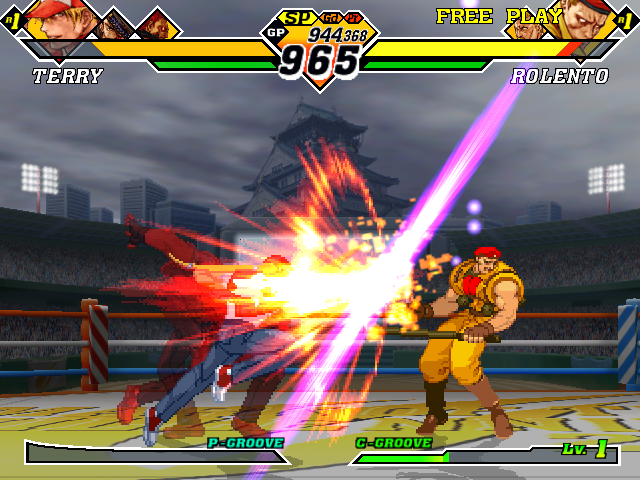

Back at the beginning of a new millenium in 2000, Capcom partnered with SNK to provide a full-out crossover fighting game between their franchises, and these being at a high level in the mainstream at that point (the earlier golden years and the success of Street Fighter and The King of Fighters games were still fresh in people's heads). Capcom VS SNK, which had a single revision adding Dan and Joe, was mainly developed by Capcom, and while most SF characters reused their Street Fighter Alpha sprites, the main characters of Capcom and EVERY single SNK character had a set of new fresh sprites, used 4 buttons (which was a deviation from their usual 6 button), a team system with ratio tiers (4 spaces, some characters took more than one space depending of their strength), and had the choice between Capcom Groove and SNK Groove, which affected mechanics and the super bars.
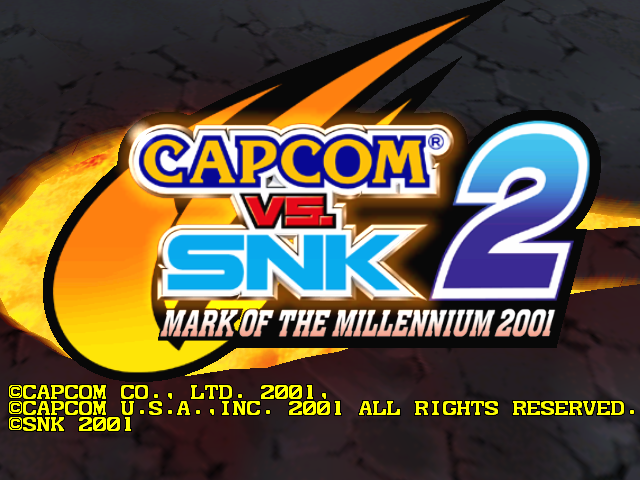
Now, CVS1 was a huge thing with its premise, polished gameplay and graphics taking advantage of the NAOMI hardware (which would also make ports to the Dreamcast virtually guaranteed, and even then it got ported to PS1 too)...but that game would be overshadowed in history by none other than its sequel. Capcom VS SNK 2 made even more waves as it came only a year after the first game, but expanded the roster by a large margin and changed a lot of things for the better, three of which would be the control scheme going back to the classic 6-button scheme, revamping the grooves, and changing the ratio system so that you can pick up to 3 characters and set yourself the ratio.
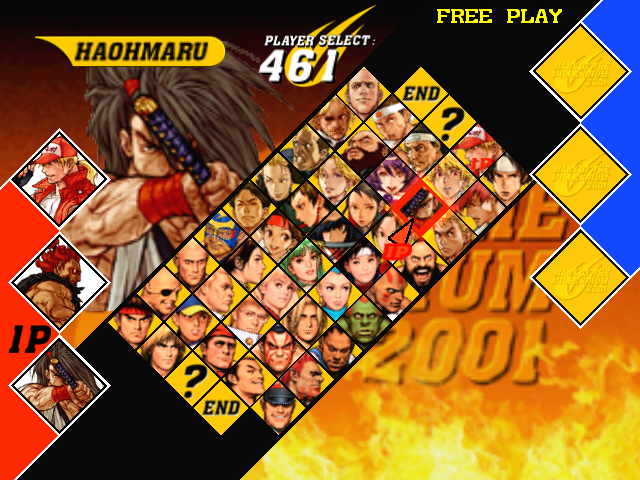
Would you want two Ratio 1 fighters and one Ratio 2 fighter? Or would you prefer two R2 fighters for a balanced pair? Maybe have one Ratio 1 fighter and the other one with Ratio 3 to have a warm-up before using your strongest fighter? Or instead just go all-out with a single Ratio 4 character? The choice is up to you! While CVS1's Ratio system basically "balanced" stuff by not letting you use many strong characters in a team, CVS2's Ratio system freely lets you pick which characters would you like to have dealing more damage, and it does give an interesting spin on the usual 3-on-3 format in flexibility and choice, since you can also pick the character order before each match...so if you want to start with your strongest fighter, you can!
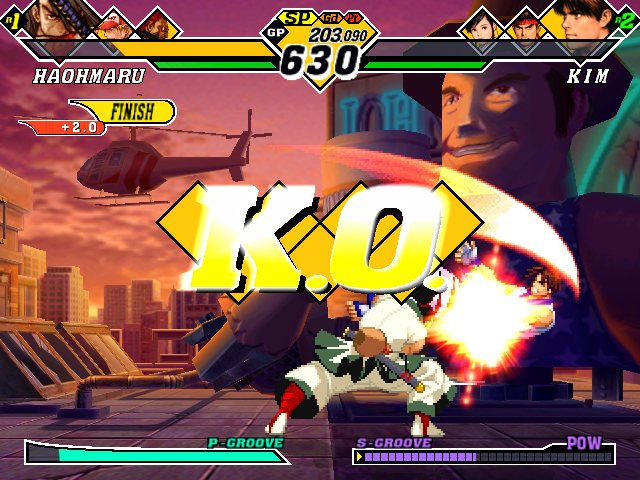
On top of that, the Grooves are now not just "Capcom" and "SNK", but instead there are 6 grooves to pick from: 3 based from Capcom games, and 3 based from SNK games. On top of general differences like dash/run and roll/evade between Capcom and SNK grooves, each groove has their own nuances taken from the games that they were inspired on.
- C-Groove: Based off Street Fighter Alpha 3, and gives you Alpha Counters and a 3-level super bar, allowing you to use Lv1 to Lv3 supers, and cancelling Lv2 supers.
- A-Groove: Based off Street Fighter Alpha 2, and its main strength is to allow using the Custom Combo from SFA2.
- P-Groove: Based off Street Fighter III: Third Strike, and while it only has a single super bar for Lv3 supers, it also allows you to do the mythical Parry by pressing forward to nullify attacks...as long as you do it properly.
- S-Groove: Based off KOF94 (and KOF98's Extra mode), and uses a single bar that can be charged manually (or by receiving damage) and puts you in "MAX Mode" while full, giving you a bit more of strength and stronger supers. You also get free Lv1 supers if at low health.
- N-Groove: Based off KOF98's Advanced mode, you get a bar that can save up to 3 stocks (or more if you are at disadvantage), and lets you spend them to use supers or to activate MAX Mode.
- K-Groove: Based off Samurai Shodown and Garou MOTW, you get a single bar that fills up exclusively by receiving damage, and the Just Defense mechanic (press back right before getting hit; similar to parry but not as risky and not as advantageous). Can be risky, but the buff from the bar getting full (including access to a Lv3 super) can be used for a big comeback.
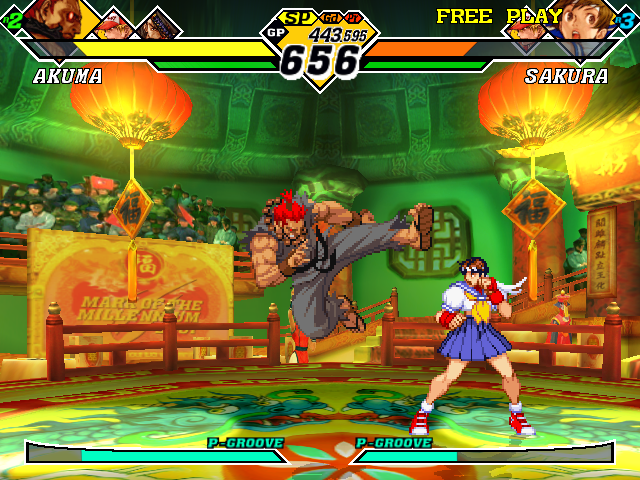
The presentation is very dynamic and bombastic, with fights being at different places over the world and crisp animated sprites, cool voice acting (unlike most of Capcom sprites, all of this is brand new), a very distinct HUD and one of the most beloved announcers in fighting games ever. There's nothing that would fit more in a fighting game where you pit the best of the best in a world tournament that a voice that knows how to hype it up.
"This battle is gonna be a must-remember! FIGHT!!"
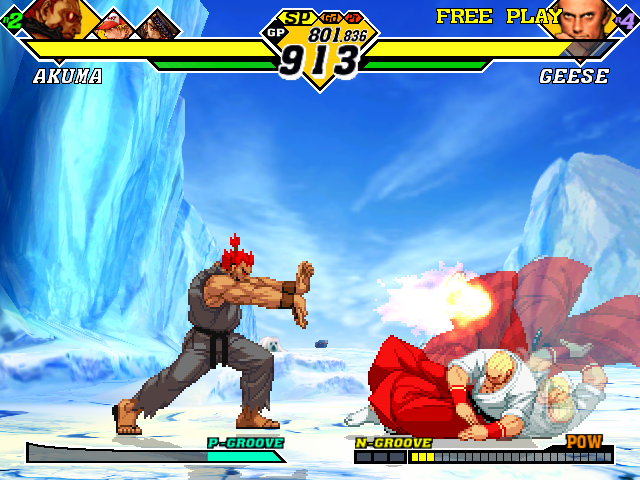
Something that was brought back from CVS1 when playing solo is the GP system, which is a number that increases when you hit the enemy with attacks and specials (along with bonuses like finishing with a super attack, not losing any team member, etc) and decreases if you get hit and have to continue. This is key for not only unlocking a fight with Bison or Geese (where they will trigger a "Challenger Approaching" prompt and fight you by themselves), but also for what you will face after the last normal match set in Osaka. If you have enough points...someone will show up.
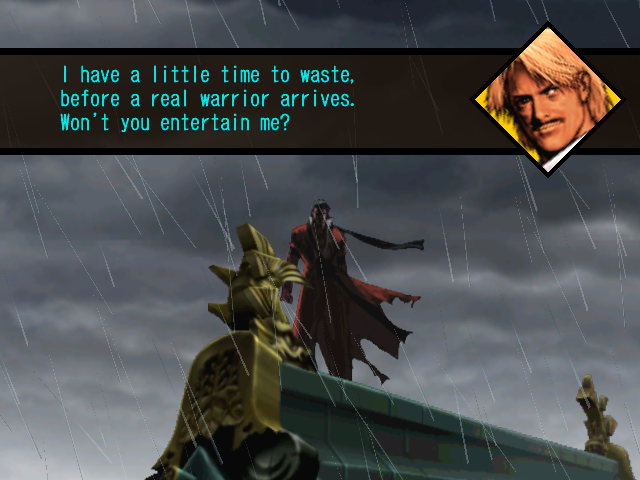
You can end up fighting either Akuma or Rugal, putting up a big fight by themselves at a rooftop during a storm while there's no music playing. This does give a very fitting feeling to the fight, facing a powerful enemy wanting to prove their power...but their message about "waiting before a real warrior" is a hint that they aren't at their biggest strength yet. With a higher GP score, they will be fighting between each other instead...and whoever ends up surviving will be stronger than ever, and will make sure that you definitely don't survive.
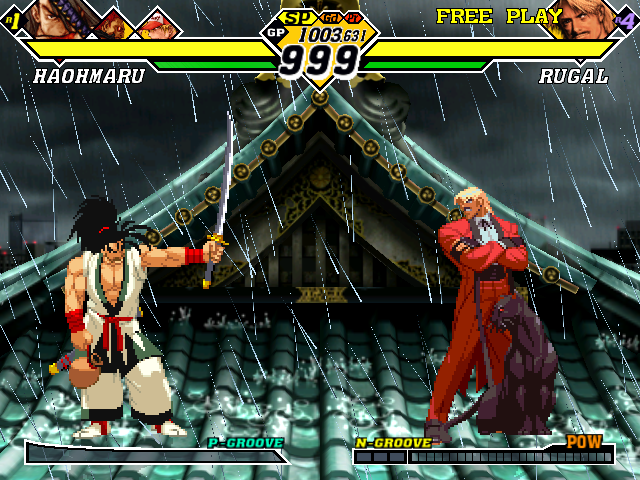
There's a reason why Capcom VS SNK 2 is so beloved in the community after so long: On top of being one of the very few games where both companies have collaborated on an actual fighting game and haven't done so again for 2 decades (which would disqualify Ryu, Ken and Terry in Smash, and most recently, SF characters in KOF All Stars, since that one is a mobile game), it is a very slick looking and playing game. The fact that it got international ports on the PS2, Gamecube and Xbox also helped this game to be more popular than its predecessor. Nowadays on top of those consoles, you can emulate it with any Dreamcast or NAOMI emulator (preferrably with Flycast; Fightcade supports playing the arcade version of this online through said emulator), since it also hasn't been re-released again despite popular demand.
But well, until the day that Capcom decides to port this game to new consoles (or even better, makes a Capcom VS SNK 3), doing what we can on our own is currently the best option to enjoy this game, by yourself and with others. It is definitely a legendary fighting game worth playing.
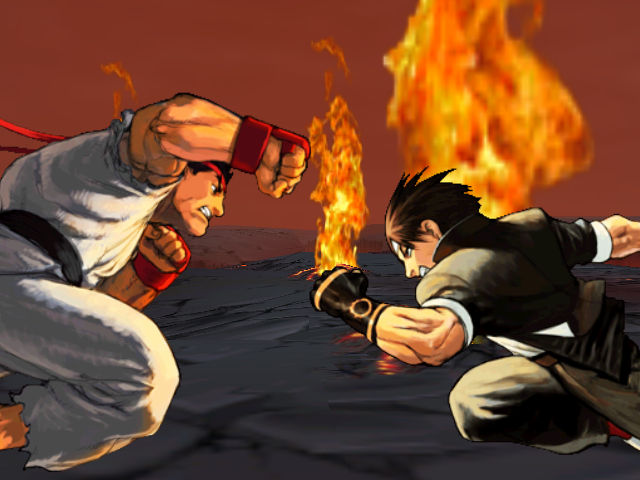

Spanish translation with DeepL. All screenshots were captured by myself.
Español
A principios del nuevo milenio, en el año 2000, Capcom se asoció con SNK para ofrecer un juego de lucha completamente cruzado entre sus franquicias, estando éstas a un alto nivel en la corriente principal en ese momento (los años dorados anteriores y el éxito de los juegos de Street Fighter y The King of Fighters aún estaban frescos en la cabeza de la gente). Capcom VS SNK, que tuvo una única revisión añadiendo a Dan y Joe, fue desarrollado principalmente por Capcom, y mientras la mayoría de los personajes de SF reutilizaban sus sprites de Street Fighter Alpha, los personajes principales de Capcom y TODOS los personajes de SNK tenían un conjunto de sprites nuevos y frescos, usaban 4 botones (lo que suponía una desviación de sus 6 botones habituales), un sistema de equipos con niveles de relación (4 espacios, algunos personajes ocupaban más de un espacio dependiendo de su fuerza), y tenían la posibilidad de elegir entre Capcom Groove y SNK Groove, lo que afectaba a las mecánicas y a las superbarras.

Ahora bien, CVS1 fue algo enorme con su premisa, su pulida jugabilidad y sus gráficos aprovechando el hardware NAOMI (que también haría que los ports a la Dreamcast estuvieran prácticamente garantizados, e incluso entonces se portó también a PS1)... pero ese juego quedaría eclipsado en la historia nada menos que por su secuela. Capcom VS SNK 2 causó aún más sensación, ya que llegó sólo un año después del primer juego, pero amplió el plantel con creces y cambió muchas cosas para mejor, tres de las cuales serían el esquema de control volviendo al clásico esquema de 6 botones, la renovación de los surcos y el cambio del sistema de ratios para que puedas elegir hasta 3 personajes y establecer tú mismo el ratio.

¿Querrías dos luchadores de Ratio 1 y uno de Ratio 2? ¿O prefieres dos cazas R2 para tener una pareja equilibrada? ¿Quizás tener un caza de Ratio 1 y otro de Ratio 3 para tener un calentamiento antes de usar tu caza más fuerte? ¿O, por el contrario, ir a por todas con un único personaje de Ratio 4? La elección depende de ti. Mientras que el sistema de Ratio de CVS1 básicamente "equilibraba" las cosas al no permitirte usar muchos personajes fuertes en un equipo, el sistema de Ratio de CVS2 te permite elegir libremente qué personajes te gustaría que hicieran más daño, y le da un giro interesante al formato habitual de 3 contra 3 en cuanto a flexibilidad y elección, ya que también puedes elegir el orden de los personajes antes de cada partido... ¡así que si quieres empezar con tu luchador más fuerte, puedes hacerlo!

Además, ahora los surcos no son solo "Capcom" y "SNK", sino que hay 6 surcos para elegir: 3 basados en juegos de Capcom y 3 basados en juegos de SNK. Además de las diferencias generales, como la carrera y el rodaje, entre los surcos de Capcom y SNK, cada surco tiene sus propios matices tomados de los juegos en los que se inspiraron.
- Groove-C**: Basado en Street Fighter Alpha 3, y te da contadores Alpha y una barra de super de 3 niveles, permitiéndote usar supers de Lv1 a Lv3, y cancelar supers de Lv2.
- A-Groove: Basado en Street Fighter Alpha 2, y su principal fortaleza es permitir el uso del Custom Combo de SFA2.
- P-Groove: Basado en Street Fighter III: Third Strike, y aunque sólo tiene una única barra de super para los supers de Lv3, también permite hacer el mítico Parry pulsando hacia delante para anular los ataques... siempre que lo hagas correctamente.
- S-Groove: Basado en KOF94 (y en el modo Extra de KOF98), y utiliza una única barra que se puede cargar manualmente (o recibiendo daño) y te pone en "Modo MAX" mientras está lleno, dándote un poco más de fuerza y supers más fuertes. También obtienes supers de Lv1 gratis si tienes poca salud.
- N-Groove: Basado en el modo avanzado de KOF98, obtienes una barra que puede guardar hasta 3 acciones (o más si estás en desventaja), y te permite gastarlas para usar supers o activar el Modo MAX.
- K-Groove: Basado en Samurai Shodown y Garou MOTW, tienes una única barra que se rellena exclusivamente al recibir daño, y la mecánica Just Defense (pulsar hacia atrás justo antes de ser golpeado; similar al parry pero no tan arriesgado y no tan ventajoso). Puede ser arriesgado, pero la ventaja de que la barra se llene (incluyendo el acceso a un super Lv3) puede utilizarse para una gran remontada.

La presentación es muy dinámica y ampulosa, con combates en diferentes lugares del mundo y nítidos sprites animados, un genial doblaje (a diferencia de la mayoría de los sprites de Capcom, todo esto es nuevo), un HUD muy marcado y uno de los locutores más queridos de los juegos de lucha de todos los tiempos. No hay nada que encaje mejor en un juego de lucha en el que se enfrenta lo mejor de lo mejor en un torneo mundial que una voz que sepa cómo darle bombo.
"This battle is gonna be a must-remember! FIGHT!!"

Algo que se trajo de CVS1 cuando se juega en solitario es el sistema de GP, que es un número que aumenta cuando golpeas al enemigo con ataques y especiales (junto con bonificaciones como terminar con un súper ataque, no perder a ningún miembro del equipo, etc) y disminuye si te golpean y tienes que continuar. Esto es clave no solo para desbloquear un combate con Bisontes o Gansos (donde activarán un aviso de "Se acerca un retador" y lucharán contra ti por sí mismos), sino también para lo que te enfrentarás después del último encuentro normal establecido en Osaka. Si tienes suficientes puntos... alguien aparecerá.

Puedes acabar luchando contra Akuma o Rugal, dando una gran pelea ellos solos en una azotea durante una tormenta mientras no suena la música. Esto da una sensación muy adecuada a la lucha, enfrentándose a un poderoso enemigo que quiere demostrar su poder... pero su mensaje sobre "esperar antes que un verdadero guerrero" es una pista de que aún no están en su mayor fuerza. Con una puntuación de GP más alta, lucharán entre ellos en su lugar... y quien acabe sobreviviendo será más fuerte que nunca, y se asegurará de que tú definitivamente no sobrevivas.

Hay una razón por la que Capcom VS SNK 2 es tan querido por la comunidad después de tanto tiempo: Además de ser uno de los pocos juegos en los que ambas compañías han colaborado en un juego de lucha real y no lo han vuelto a hacer en 2 décadas (lo que descalificaría a Ryu, Ken y Terry en Smash, y más recientemente, a los personajes de SF en KOF All Stars, ya que ese es un juego para móviles), es un juego de aspecto y jugabilidad muy hábiles. El hecho de que tuviera adaptaciones internacionales en PS2, Gamecube y Xbox también ayudó a que este juego fuera más popular que su predecesor. Hoy en día, además de esas consolas, se puede emular con cualquier emulador de Dreamcast o NAOMI (preferiblemente con Flycast; Fightcade permite jugar a la versión arcade de este online a través de dicho emulador), ya que tampoco ha vuelto a ser reeditado a pesar de la demanda popular.
Pero bueno, hasta el día en que Capcom decida portar este juego a las nuevas consolas (o mejor aún, haga un Capcom VS SNK 3), hacer lo que podamos por nuestra cuenta es actualmente la mejor opción para disfrutar de este juego, por uno mismo y en compañía. Es, sin duda, un juego de lucha legendario que merece la pena jugar.


Traducción al español hecha con DeepL. Todas las fotos capturadas por mí.



